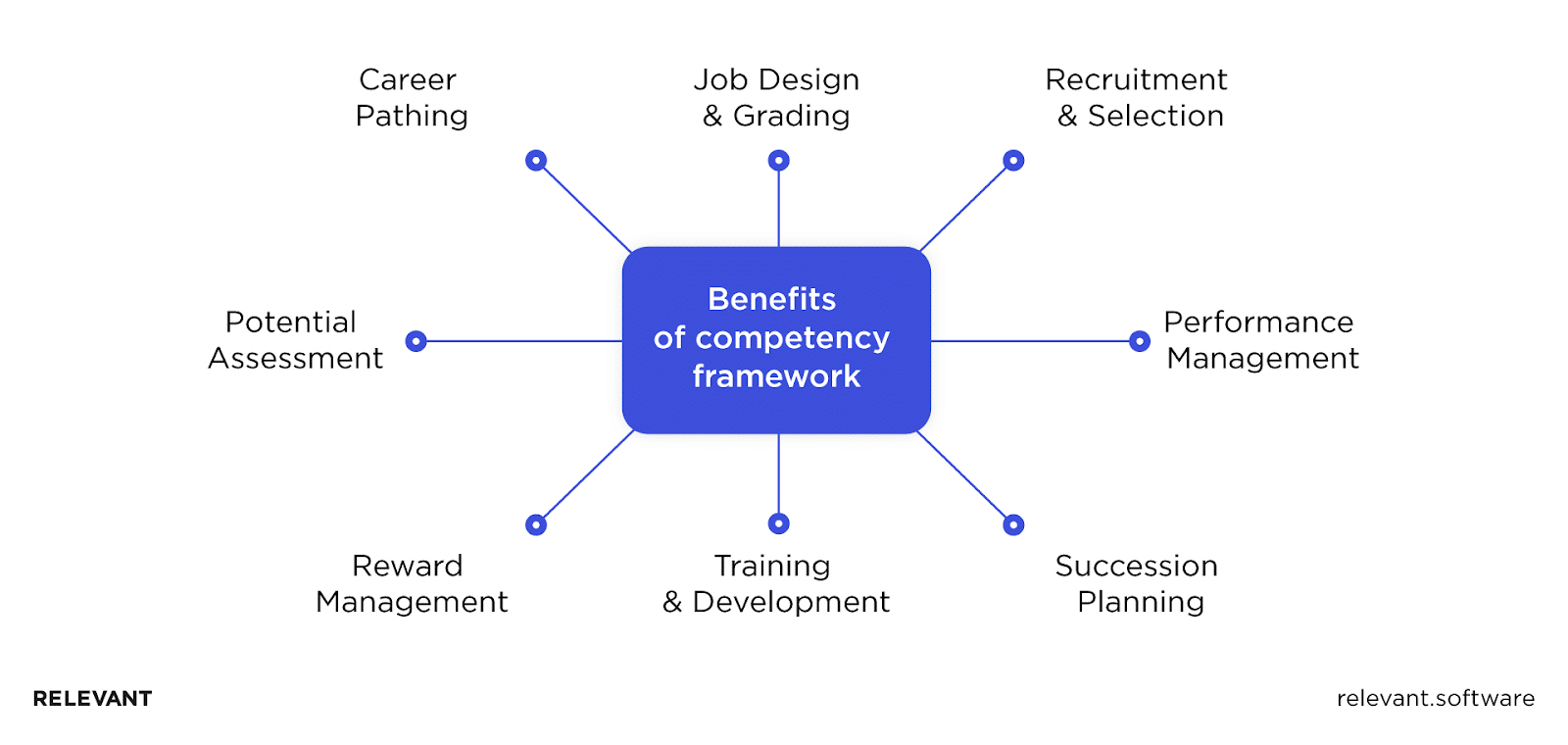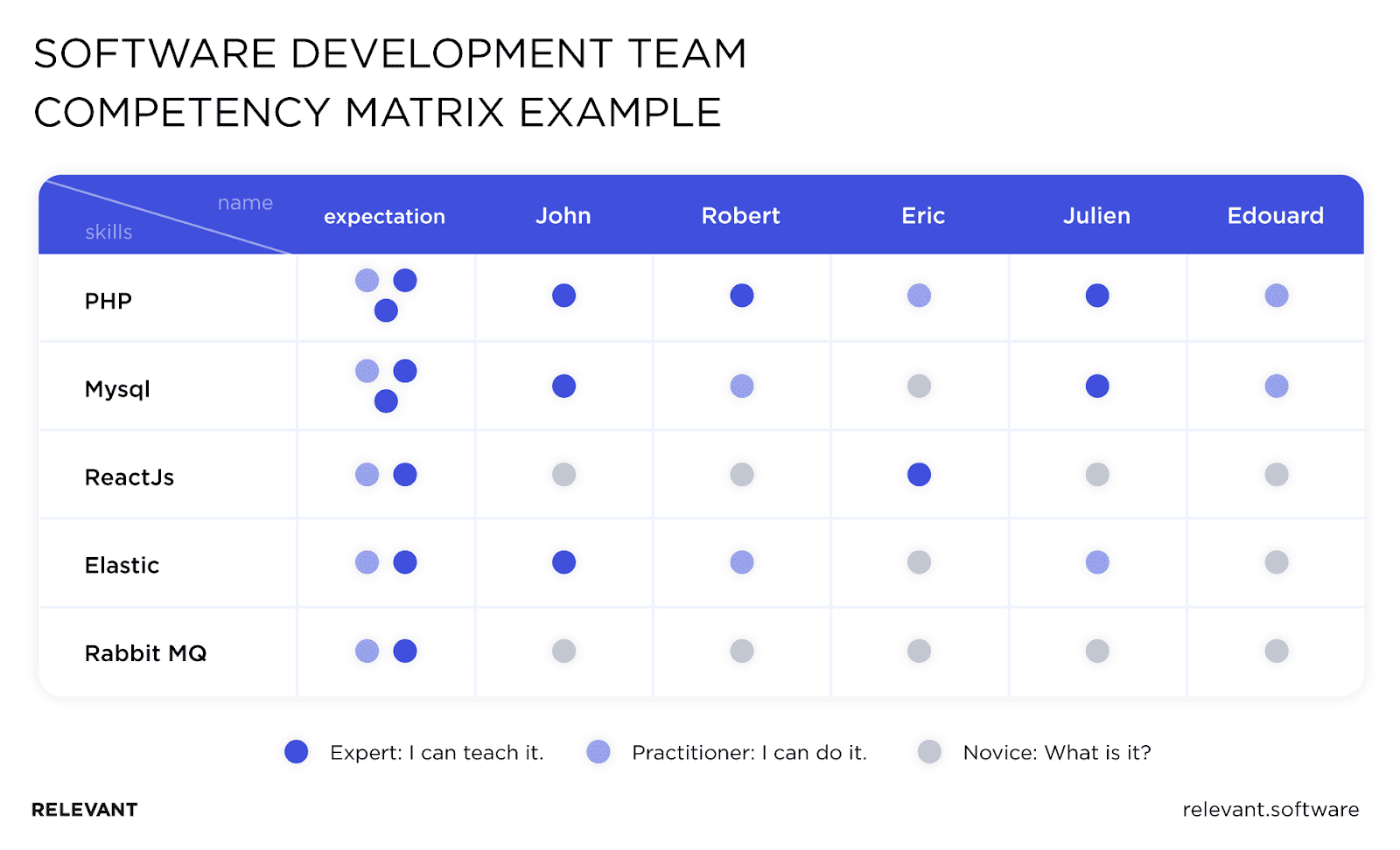Engineering Competency Matrix: What It Is and How to Build One

If you think only big companies need to codify their processes, we have bad news for you. When it comes to an engineering competency matrix, both small teams and enterprises can benefit from it. But is developing and preaching it worth your time and effort?
A competency matrix, or skills matrix, is a tool you use to define and visualize your employees’ skills at hand, as well as required and desired competencies. If built properly, this grid will become a useful supplement for data-driven HR processes, company scaling, and profitability increase. Here’s why.
What is a competency matrix used for?
Competency matrices are designed to pinpoint the required competencies for a project and identify skill gaps. All in all, there are several issues a competency matrix can help with:
- understanding the experience and level of skills currently available within the team
- identifying skill gaps
- recognizing high-risk areas where one person is responsible for critical tasks
- scaling
- restructuring for higher efficiency
- creating evaluation and training programs
A competency matrix for a software development team or company creates a structure HRs and recruiters use for job descriptions and interviewing. It also helps set expectations and goals for team members about individual learning and business growth, making performance discussions objective and unbiased.
Different-sized companies will have different goals and focus when building a competency matrix. For startups, the primary goal may be assessing the required skills for the project. In this case, you’ll create an engineering competency matrix to overview the expertise you lack to successfully fulfill a task. Other companies may focus on evaluating the skills at hand and adequately billing the team’s expertise.
Benefits of an engineering competency matrix

You should view a competency matrix as a tool for making data-driven business decisions. Its use isn’t limited to the HR department – you can apply the matrix across all teams and levels: to individual employees, the whole company, and its customers.
Individual
With visualized requirements, objectives, and job descriptions, it’s easier for employees to understand their tasks and responsibilities on their immediate level and know the cost of their skill set. More than that, employees can see what they need to master to climb up the career ladder and who can help them learn within the company.
Team
A competency matrix is primarily a tool for small to midsize teams as it helps gain visibility of the skills available and skills missing for a certain project. Thus, the team can quickly find the necessary people and complement its expertise for successful project development. Quickly is the main characteristic here since if you have a grid before your eyes, you know what specialists you’re looking for and how much they cost.
Company
At a larger scale, an organization gets an overview of its resources, evaluates the gaps, and can allocate budget for closing these gaps either by hiring the necessary specialists or launching some training. Also, internal resources can be restructured to cover the critical current tasks or increase efficiency where it’s needed. More than that, a competency matrix helps manage the salary budget, evaluation sessions, and new employees’ onboarding.
Customer
Having a clear understanding of skill gaps and the ability to quickly and effectively fill them helps software development companies provide better service to their customers.
[e-book id=”6910″]
How to create an engineering team competency matrix: steps and examples
Building a competency matrix isn’t a one-day task, but if you have a plan, you’ll be able to take every aspect into account and get a grid ready for feedback and usage. Here’s what you need to do:
1. Assign a person responsible for the competency matrix creation
At first, it seems unnecessary since building a grid doesn’t look like a tedious task that needs full-time attention. Still, if you move it to the background, you’ll spend months gathering information, evaluating teams, writing descriptions, and getting feedback. Instead, you need a matrix ready as soon as possible to start improving your processes and filling in the skills gaps immediately.
2. Define the goals of your competency matrix
The goals depend on your company size, your current state of business processes, and your plans. Is it a performance evaluation you are focused on? Or do you need to form a team for a new project and have to define skill gaps? Or, maybe, your hiring process needs improvement, and this is your number one priority? Knowing the use cases for the competency matrix will help you ask the right questions and sort out the things that need to go first.
Also, you have to understand who will be affected by the matrix: are you building it for the entire company, a specific project, or the testing team? This will influence the competencies you codify and the level of abstraction you need to use.
3. Have your company/team values in place
Define what matters to you as a team or company, both in technical and soft skills. What are the traits that make your team productive and result-oriented? What people make great coworkers in addition to excellent professionals? Do you need ambitious juniors, fast-learners, competent and independent specialists?
You may argue that your priority is technical competency, and anything else is non-essential. However, as our experience shows, defining your values and looking for people who share them is vital for a healthy and productive working atmosphere. And even remote work doesn’t eliminate this insight.
4. Define competency levels
At this point, you need a set of titles and generalized responsibilities for each one. Start from high-level guidance first, and then dive deeper into every position. To achieve that, a person responsible for competency matrix creation has to speak to employees, run some market research, consult HRs, and C-levels.
Simply speaking, the goal of this step is to build the X-axis of your grid: as the title grows, the responsibilities are added and the impact on a project, team, company increases.
5. Write descriptions
This is the most time-consuming step. It presupposes filling the framework with “position descriptions.” What can and should every person on each level do and know? To make this stage less complicated, it’s better to break it into several sub-tasks:
- define the highest level of competency for every title
- merge competencies where it’s possible: while you are filling in the grid, you may find out that separate skills lead to similar behaviors, which allows you to shorten the list
- get to the rest of competency levels
6. Run feedback sessions
You can’t create a competency matrix and then just present it to the people affected by it without testing. Since the document you are creating will influence the hiring process, the company’s culture, and the employee’s career growth, it’s only fair to test all aspects of the matrix and gather coworkers’ feedback.
Note that after you’ve improved your competency matrix according to various comments, it’s still not the final version of the document. The matrix has to be reviewed and updated now and then, since the size of the company or team, as well as its goals and directions, are changing. We recommend agreeing upon the specific time to regularly review the matrix, say, every six months.
Engineering competency matrix examples
To provide you with the visualized version of all the steps mentioned, here are several examples of successful engineering team competency matrices.

On this scheme, the highest level is Expert:
- Expert: I can teach it.
- Practitioner: I can do it.
- Novice: What is it?
This simplified competency matrix reveals skill gaps and helps find the necessary expertise on the market quickly or seek outstaffing services.
An engineering team competency matrix from an established tech company
If you’re creating a competency matrix for an entire company, it should include various aspects of the work processes, from technical skills on multiple levels and fields, to security, communication, and collaboration. Here is an example of a competency matrix from CircleCI. Some competencies will be irrelevant for specific titles or levels, and some skills outside the technical expertise will be critical for certain positions.
On the company level, a competency matrix will help define if it’s more profitable to mentor and teach juniors, be involved in the tedious recruiting process, or look at outstaffing options.
Summing up
Whether you are a startup or an established tech company, a competency matrix will be beneficial for your employees, teams, the company as a whole, and your customers. It reveals issues with expertise, brings order to your company structure, provides solid backup for the HR department, and makes recruitment way easier. But most importantly, a skills matrix clearly shows the skill gaps you have to fill immediately and helps calculate the cost of doing that.
Speaking of skill gaps, if you detect some, we’ll be happy to help you fill them. Check out our outstaffing services, or contact us to find out more.




